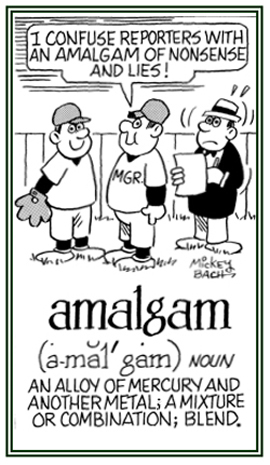amalga-
(Latin: Medieval Latin amalgama, perhaps from malagma, "poultice" or "plaster")
2. Any alloy (or "mixture of metals") of mercury with another metal or other metals: Pure metals are rarely ever used, instead they are deliberately mixed in order to produce hundreds of new substances with desirable qualities that are not available except with amalgams.
The term amalgam has been used for more than 150 years in dental restorations; only gold has been used longer for this purpose.
Are Amalgam Fillings in the Teeth a Danger to One's Health?
It is silver amalgam (mercury plus several metals, mainly silver) and no silver by itself that is used for "silver fillings" in teeth.
The amalgam is soft enough to knead (squeeze or press) into the cavity, while chemical reactions harden it after waiting for a short time.
It is known that a fraction of the mercury in amalgam is absorbed by the body and that people with amalgam restorations in their teeth have higher concentrations of mercury in various tissues (including the blood, urine, kidneys, and brain) than people without amalgam fillings.
It was not until about 1980 that serious consideration was given to the possibility that mercury vapor escaping from amalgam fillings might be affecting health, specifically producing subtle effects on the central nervous system. Such effects have been reported among dentists and other dental personnel, whose exposures are well below industrial levels but above those from fillings alone.
In 1993, the Public Health Service of the U.S. Department of Health and Human Services published a report acknowledging that scientific data are insufficient to conclude that amalgam fillings have compromised health. Furthermore, there is no evidence that removal of amalgam fillings has a beneficial effect on one's health; however, there are others who claim that over time, there is serious health damage.
Apparently, further studies will be needed to determine whether the combined exposure to the metals in dental amalgam may lower a person's condition for adverse immunological reactions.

Go to this Word A Day Revisited Index
so you can see more of Mickey Bach's cartoons.
2. To blend with another metal; to alloy a metal with mercury, or to be alloyed with mercury: Silver must be amalgamated with a harder material in order to make durable jewelry.
3. Etymology: from 1660, in Boyle's New Experiments, verb use of earlier (1642-1647) participle amalgamate, perhaps it was borrowed from Medieval Latin amalgamatus, past participle of amalgamare, "to mix, to blend".
Originally, amalgamate was a mixing of an alloy or metal with mercury; however, now it usually means "to combine a number of elements into a whole"; such as, when two company boards vote to amalgamate their firms into one organization.
2. The mixing of mercury with another metal, or metals, to form an alloy: The jewelry manufacturer used an amalgamation of silver and stronger metals to create a design that was both durable and beautiful.
3. The process for the separation of metal from a base ore using such a chemical as mercury: The mine engineer explained that the amalgamation of gold was a complicated chemical process.
Few American abolitionists were proponents of amalgamation, but many were called amalgamationists by proslaveryites in the two decades or so before the Civil War in the U.S.
This American term of amalgamationist has been applied to anyone who favors a social and genetic mixture of whites and blacks and was first recorded in 1838, when Harriet Martineau complained that people were calling her an amalgamationist when she didn't even know what the word meant.
Harriet Martineau (June 12, 1802–June 27, 1876) was an English writer and philosopher, renowned in her day as a controversial journalist, political economist, abolitionist and "a life-long feminist".
Amalgamationist quotes
2. Black America, the masses, are equally opposed to the integration and amalgamation of the races.
3. The drive for more and more amalgamation is, and always has been spearheaded by those "coloureds" who maintain a separatist society within the black race, and who are not, and never have been, identified with the black masses.
2. A machine for mixing mercury and an alloy to make a dental compound: The amalgamator measured the quantities of mercury and alloy that were placed in a capsule, which was rapidly vibrated for a few seconds by means of an electric motor.
Copper amalgam usually stays in place after it has been inserted into the tooth cavity.
